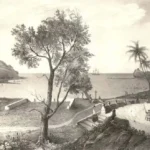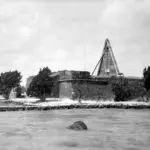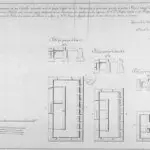Spanish Forts of Guam Overview
Table of Contents
Share This
Built to defend the island
In order to protect Spain’s interests in Guam and its Pacific trade routes, several fortifications were constructed to defend the island. Beginning with the first stockade in Hagåtña in 1671 and ending with the semi-reductos (half-enclosed parapets) in 1835, the Spanish administration built 14 fortifications of various types and dimensions in Guam. Most of these defensive structures were open batteries designed for cannons to fire through embrasures. Six fortifications were constructed in the village of Hagåtña. Four fortifications were built to protect Humåtak Bay. Three fortifications were built to defend Apra Harbor, and one unnamed battery was assembled in Malesso’ to protect the anchorage outside the village.
Acapulco-Manila galleon trade
Although Miguel López de Legazpi officially claimed Guam as a Spanish possession in 1565, the island was relatively unaffected by the symbolic gesture, as the first Spanish settlement was not established until 1668. Spain’s primary interest in the island for the first hundred years of colonization revolved around the Acapulco-Manila galleon trade. For 250 years (1565 – 1815) merchant ships crossed the vast Pacific Ocean connecting Manila with Acapulco and eventually Spain. Guam’s location made it a convenient and important provisioning station and landmark for these ships during the long Acapulco to Manila leg of their voyage.
In the early years of the galleon trade, however, ships were not required to anchor at Guam. The westbound ships from Acapulco occasionally anchored at Humåtak Bay, but usually they merely slowed their speed with furled sails in order to trade pieces of iron for provisions with the many eager CHamorus/Chamorros that sailed toward them in their proas. Additionally, the eastbound ships from Manila were still well-provisioned and sailed northeast with the monsoon winds, avoiding Guam and the rest of the Mariana Islands on their return route to Acapulco.
Construction of fortifications
However, in 1668, Guam entered into an era of drastic change under Spanish rule. In June of that year, Father Diego Luís de San Vitores led four Jesuit missionaries and a small group of military and lay escorts to Guam in order to establish the first Spanish mission and colony in the Mariana Islands. By this time, introducing Christianity to the CHamorus was not a novel idea. However, San Vitores was the first to successfully negotiate support for the new mission. The Jesuits established their headquarters in the central village of Hagåtña.
Despite the protection provided to the Jesuits in the form of a small complement of Spanish and Filipino soldiers, the Mariana Islands were a dangerous mission for the Jesuits. The new colony was dependent on the Spanish galleons, now mandated to stop at Guam to provide supplies and support to the mission. CHamoru resistance against Spanish colonization steadily increased in the years following San Vitores’ arrival. This hostility was in part the result of the Jesuits seeking to change the long-established lifestyle of the independent islanders. By 1671, the first fortification in the form of a stockade was built in Hagåtña to protect the mission and ward off a large-scale attack led by the high-ranking Chamorri, or high-caste member, named Hurao.
Accordingly, the first fortification was built to protect the Spanish colonizers from CHamoru rebels. In the years to come, fortifying the island would be in response to the growing number of non-Spanish ships sailing through the Pacific. These ships, often sailed by pirates or privateers, posed a threat in the eyes of Spain to it’s profitable silver-laden galleon trade and missionary endeavors in the region.
The Spanish concentrated their defensive efforts in four primary locations: Hagåtña, Humåtak, Malesso’, and Apra Harbor. Hagåtña was selected as a settlement site by San Vitores because it was the largest CHamoru settlement accessible by ship. Hagåtña was later declared the capital city of the Mariana Islands and became home to all of Guam’s Spanish governors. From 1671 to 1835, a total of six Spanish fortifications would be built at this seaside village.
Although Hagåtña became the primary settlement for the Spanish colony, offloading supplies at this location was often dangerous because of the reef. Spain requested that the missionaries find a safer harbor for the ships to offload their supplies. Humåtak eventually became the principal site for vessels to anchor and offload their goods. Malesso’ was also designated as layover port for the Cavite supply ships as they waited for favorable trade winds to take them back to the Philippines. From 1680 to 1810, Spain built a battery and three stone fortifications in Humåtak to protect the bay and also assembled a battery in the village of Malesso’.
With an ever increasing threat from non-Spanish ships sailing through the region, Spain set out to find an anchorage that could be better defended than that of Humåtak and Malesso’. In 1734, a new anchorage was opened at Apra Harbor. Not only was the new anchorage easier to defend from enemy attack, it also provided better protection from inclement weather. By the 1740s, most ships anchored in the new harbor. The Acapulco ships, however, continued to offload their goods in Humåtak without anchoring and usually only stayed for one day. From 1737 to 1801, Spain built three fortifications to defend Apra Harbor.
The maintenance of Guam’s defenses proved difficult through the years. By the beginning of the 19th century, Spain was no longer the powerful nation it had once been. The independence of New Spain (Mexico), the end of the galleon trade in 1815, and the tremendous war debt Spain had incurred brought economic challenges to Guam. Although the defensive needs of the island had been continually addressed in the 19th century, bureaucracy and the financial downturn of Spain prevented it from implementing and maintaining effective defensive objectives. As a result, several visitors and governors such as Luís de Ibañez y García (1871-1873) and Francisco Olive y García (1884-1885) questioned the effectiveness of Guam’s defenses. Today, the remnants of only five of the 14 Spanish fortifications still grace the island. They include: Fort Santa Agueda, Fort Soledåd, Fort Santo Angel, Fort San Jose and Fort Santiago.
17th century fortifications
In the 17th century, Spain built three defenses on Guam: a stockade in Hagåtña, a battery in Humåtak, and a fort in Hagåtña. The first undertaking was a stockade built in Hagåtña in 1671 to protect the new Spanish settlement. The stockade was constructed of coconut tree logs, and within its walls was a church and mission housing. Two towers were built into the walls, each armed with a small brass cannon. The stockade had a force of 31 men armed with bows and arrows and some firearms. For the next 22 years, the wooden stockade, which was renovated several times, was the main defensive fortification on the island.
In 1680, the Spanish built a battery in the village of Humåtak. The purpose of the battery was to protect Humåtak Bay and the mouth of the Salupat River, which provided water to the Acapulco ships. The original name of the fortification was Nuestra Señora del Carmen, but the name was lost, and by 1831, it was mistakenly referred to as the Battery of Santa Barbara. The earliest report on the battery stated that it contained five cannons.
In 1683 the Spanish built the first stone fort in Hagåtña and named it Nuestra Señora de Guadalupe. The fort was a slightly elevated one-story structure. Its shape was quadrangular and it could hold up to 400 soldiers. Bastions located at each corner of the fort contained artillery and the fort was equipped with a catapult-type weapon that hurled stones at enemy forces.
18th century fortifications
By the early 18th century, the increasing number of non-Spanish ships sailing through the Pacific was of concern to Spain. The Council of the Indies considered the defense of the island to be essential in order to deny other forces from occupying the island and thereby threatening Spain’s galleon trade with the Philippines and missionary work in the Pacific. There were six fortifications assembled in Guam during the 18th century.
In the first quarter of the 18th century, there was evidence that a battery was in existence in Malesso’. The battery did not receive a formal name and its exact location is still under question. However, the battery was mentioned in a 1724 encounter that had occurred between the captain of a Cavite ship and Governor Luís Antonio Sánchez de Tagle. During the altercation, two cannons were brought to Malesso’ from Humåtak to reinforce the battery.
By the 1730s, Apra Harbor became a focal point for construction. The new harbor provided ships with better protection from enemies and inclement weather than did the anchorages at Humåtak and Malesso’. To protect the new anchorage two stone fortifications were built, Fort San Luís and Fort Santiago. San Luís was built in 1737 along the shoreline near present day Gab Gab Beach and protected both the outer and inner portions of the harbor with its six cannons. At a later and yet to be determined date in the 1700s, Fort Santiago was built atop Orote Peninsula to protect the main entrance to the harbor. Santiago was large enough to house six cannons and included a soldier’s quarters and munitions storage.
In 1751, Fort San Fernando was constructed in Hagåtña to protect the channel entrance. San Fernando was built in the same area that Fort Nuestra Señora de Guadalupe was built in 1683. San Fernando stood until 1799 when Governor Manuel Muro dismantled it and built Fort San Raphael to replace the dilapidated fort. San Raphael was the last of Hagåtña’s three shoreline forts and was designed to hold 17 cannons. All three forts were constructed in the location of the current Skinner Plaza. In 1756, Spain built Fort Santo Angel to help protect Humåtak Bay. The stone fort was the second fortification in Humåtak, and it was built atop a large rock structure on the north side of the bay. It was designed to house three cannons.
19th century fortifications
In the early 19th century, the Spanish, still wary of enemy invasions, constructed five fortifications. In 1800, the Spanish built Fort Santa Agueda in Hagåtña. The stone fort stood atop Apugan Hill and protected the low-lying Governor’s Palace and Fort San Raphael. The fort was designed with embrasures for 10 cannons.
In 1801, Fort Santa Cruz was built to defend Apra Harbor. By this time, Fort San Luís was in ruins and Fort Santiago could not adequately defend the harbor should enemy vessels enter the channel entrance. The stone fort, officially known as Nuestra Señora de los Dolores y la Santa Cruz, was built on the islet of Santa Cruz. It was designed with 11 embrasures for any caliber of cannon. After World War II, Fort Santa Cruz was demolished.
In 1805, Fort San Jose was constructed in Humåtak to defend the bay. The stone fort was built in response to a report that stated its predecessor, Fort Santo Angel, was in poor condition. San Jose was built on a hill above and to the north of Santo Angel and housed six cannons.
In a document dated 1810, Governor Alexandro Parreño described the completion of Fort Nuestra Señora de la Soledåd in the village of Humåtak. The stone fort was designed to help strengthen the flaws of the other forts built along Humåtak’s coastline. Soledåd could accommodate seven cannons and was located atop Chalan Aniti, overseeing the entrance and anchorage at Humåtak Bay.
The last Spanish fortification built on Guam was the semi-reductos in 1835. Concerned that well-trained ship crews could threaten his defenses, Governor Francisco Ramón de Villalobos built a semi-circular fortification to protect the governor’s palace in Hagåtña. The outer wall was made of stone masonry measuring seven and one-half feet high and four inches thick. The fort contained seven platforms for artillery and was constructed in front of the governor’s palace and extended into the present-day Plaza de España.
For further reading
Degadillo, Yolanda, Thomas B. McGrath, SJ, and Felicia Plaza, MMB. Spanish Forts of Guam. MARC Publications Series 7. Mangilao: Richard F. Taitano Micronesian Area Research Center, University of Guam, 1979.
Driver, Marjorie G. Cross, Sword, and Silver: The Nascent Spanish Colony in the Marianas. Mangilao: Richard F. Taitano Micronesian Area Research Center, University of Guam, 1993.
–––. Fray Juan Pobre in the Marianas 1602. MARC Miscellaneous Series no. 8. Mangilao: Richard F. Taitano Micronesian Area Research Center, University of Guam, 2004.
Driver, Marjorie G., and Omaira Brunal-Perry. Architectural Sketches of the Spanish Era Forts of Guam: From the Holdings of the Servicio Historico Militar, Madrid. MARC Educational Series no. 17. Mangilao: Richard F. Taitano Micronesian Area Research Center, University of Guam, 1994
Guam Department of Parks and Recreation. “Guam State Historic Preservation Office.”
Valle, Maria Teresa del. The Importance of the Mariana Islands to Spain at the Beginning of the Nineteenth Century. Edited by Marjorie G. Driver. MARC Educational Series no. 11. Mangilao: Richard F. Taitano Micronesian Area Research Center, University of Guam, 1991.
Know my history - Know my island
Guam’s only true fort
Although many of Guam’s Spanish fortifications are referred to as forts, they were mostly baterías, or batteries, which was a place where pieces of artillery were positioned. A batería could be a permanent or temporary structure, but it was usually designed as a flat platform to support the artillery pieces along with, perhaps, one or two other structures to store materials.
A fuerte, or fort, was a small fortification which included rooms, walls of variable sizes and coverage. The main difference between a batería and a fuerte is that forts may not have artillery installed. The fuerte, like a bateria, can be a permanent or temporary structure.
Guam’s only true fort was Fort Santa Cruz, constructed in 1801 to defend Apra Harbor. The stone fort, was officially known as Nuestra Señora de los Dolores y la Santa Cruz, built on the islet of Santa Cruz was destroyed shortly after World War II.



